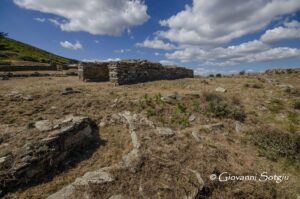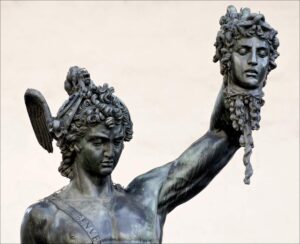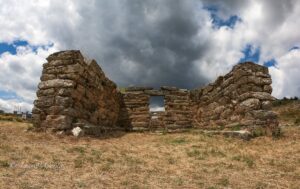Who doesn’t remember the legend of Perseus, son of Zeus and Danae, who arrived in the west wearing winged sandals to kill the Gorgon Medusa, beheading her with her hair full of snakes? The name Medusa means sovereign or mistress and seems to derive from the Sanskrit Medha, which passed into Greek as Metis and into Egyptian as Met or Maat. Mat was the goddess of rule and justice and wore a feather on her head, emblematic of the West, “the region where the dead were buried to be reborn and reach eternal life” (M.C. Betrò “Hieroglyphs”). It is equally interesting to observe how in the Sardinian language the term Sa Meri refers to the mistress. The relationships between Medusa and Sardegna have been discussed by the ethnologist Dolores Turchi in an article published in April 2003 in “Sardegna Mediterranea,” from which some excerpts are taken, one of which also mentions the megaron temple of “Sa ‘Omu de Orgia” in Esterzili.
Mat was the goddess of rule and justice and wore a feather on her head, emblematic of the West, “the region where the dead were buried to be reborn and reach eternal life” (M.C. Betrò “Hieroglyphs”). It is equally interesting to observe how in the Sardinian language the term Sa Meri refers to the mistress. The relationships between Medusa and Sardegna have been discussed by the ethnologist Dolores Turchi in an article published in April 2003 in “Sardegna Mediterranea,” from which some excerpts are taken, one of which also mentions the megaron temple of “Sa ‘Omu de Orgia” in Esterzili. “In Sardinia, we find this name (Medusa) in some legends, and Medusa is always the lady of the place, powerful and rich in treasures. In Samugheo, always in the Oristanese, there is the castle of Medusa. Another castle with this name was located in Lotzorai. Around the castle of Medusa, which is located in the territory of Samugheo, ancient legends intertwine, one of which says that the castle was connected by an underground passage to Fordongianus, where the hot springs emerge. This castle is also called Sa ‘omu de Orgìa, the house of Georgia…” It is interesting that all the legends concerning Medusa depict her fighting against people coming from the sea. In one legend told in Orune, Medusa was the lady of the place.”
“In Sardinia, we find this name (Medusa) in some legends, and Medusa is always the lady of the place, powerful and rich in treasures. In Samugheo, always in the Oristanese, there is the castle of Medusa. Another castle with this name was located in Lotzorai. Around the castle of Medusa, which is located in the territory of Samugheo, ancient legends intertwine, one of which says that the castle was connected by an underground passage to Fordongianus, where the hot springs emerge. This castle is also called Sa ‘omu de Orgìa, the house of Georgia…” It is interesting that all the legends concerning Medusa depict her fighting against people coming from the sea. In one legend told in Orune, Medusa was the lady of the place.” After the death of her father Urcheddu or Furcheddu (from Forco), she is the one who leads her people, but she loses the war and is killed in battle. Fara, in his book ‘De rebus sardois’ (1580), begins the history of Sardinia starting from Forco, father of Medusa, who succeeded him in governing the island. Forco was the king of the sea and ruled Sardinia as Poseidon, god of the sea, ruled Atlantis. According to Fara, Medusa faced Perseus, who had taken up arms against her, but was killed in battle. We thus find ourselves among the Mycenaean myths, because Perseus came from Argos and became king of Tiryns and Mycenae. But while in Greek myths Medusa is a gorgon, in Sardinian myths she appears as a beautiful and courageous queen who fights for the freedom of her people and after her death is worshiped as a goddess. Fara, being a learned person, was well aware of the Greek myth of Medusa the gorgon, so different from how it was narrated in Sardinia. He therefore thinks that this myth was distorted by the Greeks to enhance the courage of Perseus and thus writes in his history that the serpentine-haired head, which in Greece was attributed to Medusa, was a tale invented to exalt the deeds of the Mycenaean hero. According to Greek tradition, Medusa lived in the far West, in the hyperborean lands of the North, and it was here that Perseus went to fight her.
After the death of her father Urcheddu or Furcheddu (from Forco), she is the one who leads her people, but she loses the war and is killed in battle. Fara, in his book ‘De rebus sardois’ (1580), begins the history of Sardinia starting from Forco, father of Medusa, who succeeded him in governing the island. Forco was the king of the sea and ruled Sardinia as Poseidon, god of the sea, ruled Atlantis. According to Fara, Medusa faced Perseus, who had taken up arms against her, but was killed in battle. We thus find ourselves among the Mycenaean myths, because Perseus came from Argos and became king of Tiryns and Mycenae. But while in Greek myths Medusa is a gorgon, in Sardinian myths she appears as a beautiful and courageous queen who fights for the freedom of her people and after her death is worshiped as a goddess. Fara, being a learned person, was well aware of the Greek myth of Medusa the gorgon, so different from how it was narrated in Sardinia. He therefore thinks that this myth was distorted by the Greeks to enhance the courage of Perseus and thus writes in his history that the serpentine-haired head, which in Greece was attributed to Medusa, was a tale invented to exalt the deeds of the Mycenaean hero. According to Greek tradition, Medusa lived in the far West, in the hyperborean lands of the North, and it was here that Perseus went to fight her. But since in all the Sardinian myths where Medusa appears, it is said that she was the queen of these places, indeed Fara specifies that she reigned for 28 years, as the ancients passed down, it is to be presumed that the Hyperborean lands that were indicated in the far West were nothing other than Sardegna with the nearby islands.
But since in all the Sardinian myths where Medusa appears, it is said that she was the queen of these places, indeed Fara specifies that she reigned for 28 years, as the ancients passed down, it is to be presumed that the Hyperborean lands that were indicated in the far West were nothing other than Sardegna with the nearby islands.
The photos of the megaron temple Sa ‘Omu ‘e Orgia in Esterzili are by Giovanni Sotgiu, Lucia Corda, and Maurizio Cossu.

